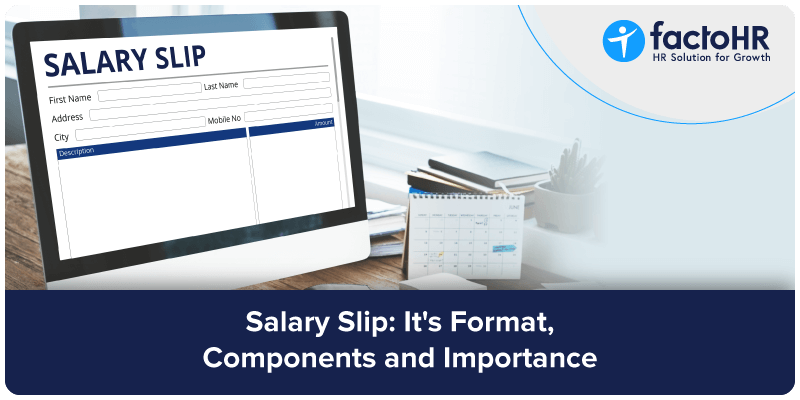Free Salary Slip Generator, It’s Format, Components and Importance

Table of Contents
In today’s fast-paced corporate world, it is critical to maintain accurate records of each employee’s salary payments. That is where salary slips can be handy. It is an essential document for employees and employers as it lets employees know how their salary is calculated, thus creating transparency in the salary payment process. Employees can also use salary slips for various purposes, including seeking employment, applying for loans, and tax planning.
However, many companies and employees need a proper understanding of the various components of a payslip. In this guide, we have explained each component and its importance. Moreover, with payroll automated software, managing salary slips has become more efficient and error-free. We have also included a ready-to-use salary slip format that employers can use in their organizations.
Free Payslip Generator
Download Free Resource
What is an Employee Salary Slip?
A salary slip or payslip is a detailed document that includes important information related to employees’ salary payments, including earnings and deduction components of the salary. Payslips are mostly issued on a monthly basis and distributed as a printed copy or through email. The main motive behind providing payslips is to help employees get a clear idea about how they are paid and help them track their income.
Employee Salary Slip Format
Each organization has their different formats of salary statements, but the basic elements remain the same everywhere. We have listed out all these important elements here:
- Name of the company, address, logo, month and year of the payment
- Particular employee’s name, employee code, job role, and the department
- Personal information such as Aadhar/PAN number and necessary bank details
- UAN (Universal Account Number) and EPF (Employees Provident Fund) account number
- Total work days, actual payable days and the total number of leaves
- All the salary earning (income) and deduction components
- Final net pay (in numbers and words)
Wage Components of Employee Payslip
As various salary components are included in the payslip, you must know each of them in detail. Here we have listed all the important wage components of the payslip.
Generally, employee wage components come under two main categories –
1. Earnings (Income)
2. Deductions
Earning Components included in the salary slip are:
Basic Salary
It is the amount of money earned by an employee before any allowances or deductions are made on their salary. It is a fixed part of the salary slip and generally includes up to 30-50% of the total salary offered to the employee.
HRA (House Rental Allowance)
It is a common part of the salary slip of most employees. Individuals who are living in a rental house can claim HRA to cover the expenses of rental accommodation.
DA (Dearness Allowance)
This type of allowance is offered to support the employees against inflation. Mostly dearness allowance is 30 to 40% of the basic pay of the employee. It is decided based on the cost of living and the employee’s location (i.e. Urban, semi-urban or rural).
Leave Travel Allowance (LTA)
Some organizations compensate their workforce to cover their travel expenditures when they are on vacation within the country. But, the employees must provide proof of the journey to claim reimbursements i.e. travel tickets. Any other expenses apart from traveling can not be considered in the LTA. This allowance can be claimed for only 2 journeys during a period of 4 years.
Performance Bonus
It is a variable income component of the employees’ payslip. Employers provide this type of bonus based on the performance of employees to encourage them towards work. It is considered as taxable, and the amount can vary across organizations.
Medical Allowance
Employees can claim this allowance by providing supporting documents for medical treatment costs incurred during their employment period. Medical allowance is considered as a taxable amount.
Conveyance Allowance
It is also known as travel allowance. Employers grant this allowance to cover employees’ traveling costs between the workplace and their residence. The actual amount may vary across companies and is often negotiable.
On the other hand, deduction components contained in the employee payslip are:
TDS (Tax Deducted at Source)
This is the advance tax deducted from an employee’s earnings and deposited with the government on their behalf. This amount can be reduced by investing in tax-exempted investments such as PPF (Public Provident Fund), ELSS (Equity Linked Savings Schemes) and tax-saving FDs. Want to get an estimated amount of your income tax? Check out our income tax calculator to get a clear idea about your tax liability.
Professional Tax
Professional tax is a payable amount based on the employee’s salary. It is a small amount deducted from an individual’s wage, and it varies across different states of India. Organizations deduct this amount from the employee’s earnings and deposit it with the government.
Employee Provident Fund
It is a mandatory saving scheme in India. The employee and employer both contribute towards the EPF account of the employee. From these accumulated funds, employees will get one time fixed lump sum amount and the pension during their retirement or he can withdraw in case of an emergency. This amount is exempted from income tax under 80 C.
ESIC (Employees’ State Insurance Corporation)
ESIC is a social security scheme offered by the government of India. Employees who are part of the ESIC scheme can get monetary benefits in case of temporary or permanent disability, illness, maternity, or even involuntary loss of employment. The employer is responsible for contributing 3.25% of the gross pay, while the deduction from the employee side is 0.75%. However, to become eligible for this scheme, employees’ earnings should not exceed Rs. 21,000.
All of these components are the crucial part of the employee salary. Check out our blog on salary structure, if you want to know more about how the employee salary is calculated.
Importance of Employee Salary Slips
For employees, keeping payslips is as beneficial as their employment certificate. These slips can help them with loan processes, planning for income tax, seeking employment and at the time of salary negotiation. Here, we have discussed why it is important in detail.
1. Used as a Proof of Employment
Employees can use payslips when they are required to provide legal proof of employment. In case employees apply for travel visas, they may need to provide a copy of the payslip as proof of their last drawn salary and job title. Besides, it can be considered as one of the most crucial documents for background checks when applying for jobs.
2. Helpful During Salary Negotiation with Prospective Employer
When a particular employee is seeking a job change, he/she may have to provide proof of employment and the pay scale at which they are working. A payslip can be helpful when negotiating with potential employers about the total CTC and its every component (i.e. basic salary, deductions, etc). Mostly every employer asks for employees’ past payslips to verify their employment and earnings.
The employees can compare the salary offered by the prospective employer with their previous pay mentioned in the payslips. So, the chances of getting a good salary will increase.
3. For Tax Planning
A payslip shows a monthly break-up of an individual’s total earnings, deductions and taxable components. The break-up of deductions includes professional tax, TDS, ESIC and EPF. It becomes crucial for employees to collect this information for the relevant financial year to determine their tax liability and plan out tax-saving investments.
So, employees must gather the values for these components for the relevant fiscal year. All of this information will be helpful to precisely determine their tax liability and plan out tax-saving investment plans accordingly. Without a salary slip, the chances of inaccurate calculations will be more, which can ultimately lead to legal issues.
If an employee’s tax liability is less than the deducted amount, then he/she can claim the refund of that excess amount as the payslip includes the amount of TDS.
4. To Avail Credit Cards and Loans
As the payslip covers all the crucial information about the individual’s wages, it can be used as a legal proof of their credit-paying ability i.e. when availing credit cards, loans, mortgages, etc. All the banks and lending institutions are required to ask for a copy of the salary slip from the person. They check the creditworthiness based on the information from the individual’s salary statements. Payslips also determine employees’ taxes in the fiscal year.
FAQs
Who is Eligible for Payslips?
Every salaried individual who is employed in a company is eligible for the payslips. As per the payroll cycle of the organization, employers distribute each employee with a copy of the payslip after the salary payments are made. If organizations do not provide payslips, in that case, employees can request a salary certificate from the employer. As tech advancement has changed the way business operates, salary statements can now be shared with employees in digital format in no time.
Are the Payslips and Salary Certificates the Same?
No, there is a clear difference between payslips and salary certificates. The payslip contains all the information related to the employee’s earnings and deductions made in monthly payments. While the salary certificate is a document that verifies an employee’s salary for a specific period. Usually, it is issued by an employer when the employee requests it. It can be used for financial or loan-related purposes.
The Major Difference Between CTC (Cost-to-Company), Gross Salary and Net Pay?
CTC is the total amount an organization spends on an individual employee. While the gross salary is the amount a company pays to the employee (before any deductions) and the net pay is an in-hand salary that the employee receives (after all the deductions).
Is Disclosing Salary Details Legal in India?
Employees should not share information about their salary packages and offered benefits. There is no specific rule from the government, but some companies may have clauses (in employment contracts) that clearly prohibits employees from disclosing their salary details.
What are the Consequences if a Company does not Provide Payslips?
Providing payslips to employees is just as important as the salary itself. If any organization refuses to share the salary slips, then employees have the right to file a complaint against them (under the labor court – state and central authority).
Grow your business with factoHR today
Focus on the significant decision-making tasks, transfer all your common repetitive HR tasks to factoHR and see the things falling into their place.

© 2025 Copyright factoHR


